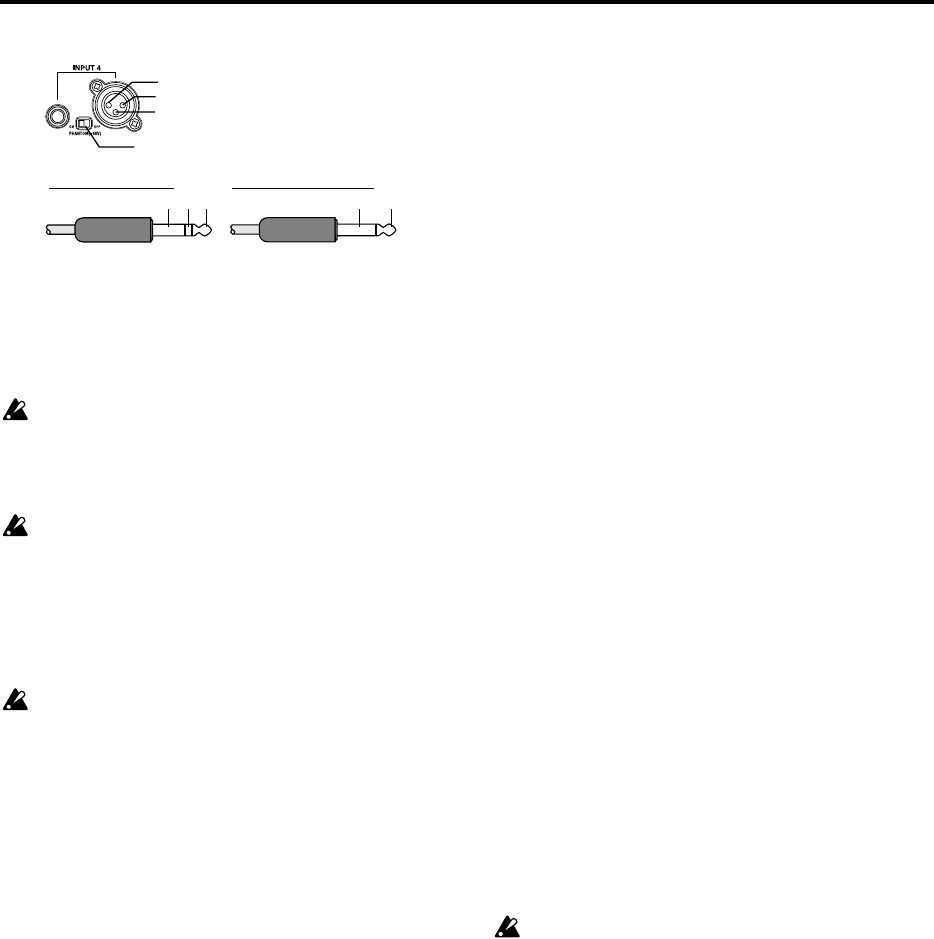
12
Phantom power switch: [INPUT 1–4] jacks provide
+48V phantom power so that condenser mics can
be used. Phantom power is supplied to the bal-
anced XLR jacks, and can be switched indepen-
dently for each channel. Turn this switch on only
for channels that use a condenser mic.
If a condenser mic is connected or disconnected
with the phantom power switch on, damage to
your equipment may occur. For this reason, always
turn the phantom power switch off before connect-
ing a condenser mic.
Never connect an unbalanced mic or device when
the phantom power switch is on. Doing so may
damage your equipment.
4 [INPUT 5], [INPUT 6], [INPUT 7], [INPUT 8] jacks
Mic/line (e.g., keyboard) sources can be input here.
These are balanced 1/4" TRS phone jacks. Unbal-
anced phone jacks can also be connected.
If you connect a plug to the [GUITAR IN] jack, no
input signal will be received from the [INPUT 8]
jack. If you wish to use the [INPUT 8] jack, discon-
nect the plug from the [GUITAR IN] jack.
5 [FOOT SW] jack
When your hands are occupied with playing an
instrument, you can use a foot switch to control
basic operations of the D1600 recorder.
A foot switch can be used to start/stop the play-
back, start/end manual punch-in recording, regis-
ter a mark, or to record tap tempo. (→p.75)
Connect the foot switch (optional PS-1) to this jack.
6 [EXPRESSION PEDAL] jack
You can use a pedal to control a specified parame-
ter of an insert effect. You can control the parameter
in realtime while you play or record. (→p.47)
Connect an expression pedal (separately sold
option, EXP-2, XVP-10 etc.) to this jack.
7 [AUX OUT] jack
Connect this to the input jack of an external effect
device.
This jack outputs the external send signal from
each mixer channel. (→p.47)
This is a 1/4" phone jack.
8 [MONITOR OUT L/R] jacks
Connect your external monitor system to these
jacks. The bus that is sent to the monitor output is
selected in the [SOLO/MONITOR] “Monitor” tab
page. (→p.109) These jacks output the same audio
signal as [PHONES].
This is a 1/4" phone jack.
9 [MASTER OUT L/R] jacks
These are analog outputs for the master LR bus
which combines the signals from each mixer chan-
nel, or for the audio source that is selected by the
Solo function. The Solo selection is made in the
[SOLO/MONITOR] “Solo” tab page.
Connect your external monitor system or recording
device to these jacks. They output the same audio
signal as the [S/P DIF OUT] jacks.
This is a 1/4" phone jack.
10 [S/P DIF OUT] jack
This is an optical-type S/PDIF format (IEC60958,
EIAJ CP-1201) digital output jack (stereo).
Use an optical cable to connect this jack to the opti-
cal digital input of your DAT or MD.
This jack digitally outputs the same audio signal as
the [MASTER OUT L/R] jacks at a sampling rate of
44.1 kHz.
11 [S/P DIF IN] jack
This is an optical-type S/PDIF format (IEC60958,
EIAJ CP-1201) digital input jack (stereo).
Use an optical cable to connect this jack to the opti-
cal digital output of your DAT or MD.
A sampling rate converter is built in. If the con-
nected source has a sampling rate of 48 kHz or 32
kHz source, it will be converted automatically to
44.1 kHz.
12 [SCSI] connector
An external hard disk drive, or removable disk
drive can be connected here, and used for record-
ing/playback in the same way as the internal
drive. An external drive can also be used for
backup. (→p.67)
In addition, a CD-R/RW drive can be connected
here to create an audio CD or to make backups.
(→p.49, 67)
This is a HD SCSI-2 (50 pin SCSI) connector.
For details on the SCSI devices that can be used
with the D1600, please contact your Korg distribu-
tor
13 [LCD CONTRAST] knob
This adjusts the contrast of the LCD screen.
The optimal setting will depend on the viewing
angle, so adjust the contrast as necessary. Looking
from the front panel, turning the knob toward the
right will darken the text, and turning it toward the
left will lighten the text.
14 [MIDI OUT] connector
MIDI messages are transmitted from this connec-
tor. Use this when you wish to control a connected
external MIDI device from the D1600. (→p.73)
15 [MIDI IN] connector
MIDI messages are received at this connector. Use
this when you wish to control the D1600 from a
connected external MIDI device. (→p.73)
2: HOT
1: GND
3: COLD
Phantom power switch
Balanced phone plug Unbalanced phone plug
GND COLD HOT
GND HOT


















